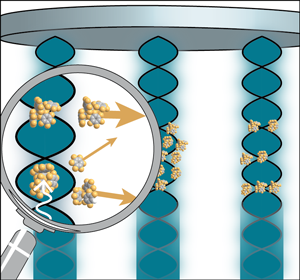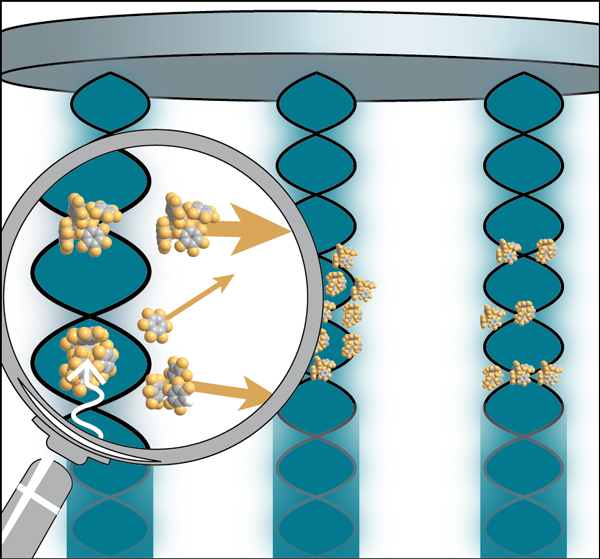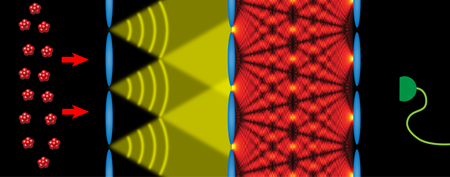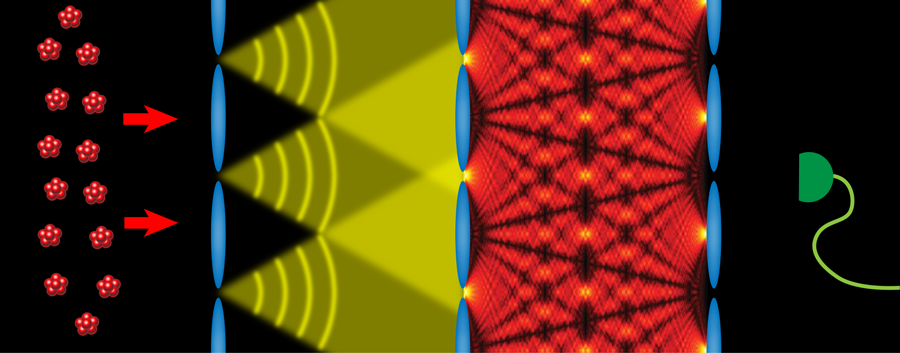Molecular Interferometry Makes a New Break
Quantum mechanics has been spectacularly successful in explaining the microscopic realm, yet exactly how it interfaces to the everyday macroscopic world is still an open question. To this end, a long-standing goal in physics has been to realize a system like that envisaged by Erwin Schrödinger in the early days of quantum mechanics in which a large object like a cat simultaneously exists in two separate states (such as “dead” and “alive”) [1]. Schrödinger originally proposed his famous “gedanken experiment” to point out a problem with quantum theories that allow for the existence of cat states and other macroscopic superpositions, which in fact do not appear in everyday life. While progress has been made in exploring the quantum-classical boundary with nanomechanical systems [2], much still remains to be done. Now physicists at the University of Vienna, Austria, have developed a new technique for observing quantum effects in the external motion of large molecules. Nadine Dörre and co-workers used three standing waves of UV light as the optical elements in a matter-wave interferometer for molecules with masses as high as 2000 atomic mass units (amu) [3]. The method can potentially be extended to the interference of larger particles, such as complex organic molecules and even small “living” organisms like viruses.
Of course, interferometers for electromagnetic waves have been a part of groundbreaking experiments for over 200 years and to this day play important roles in many fields including astronomy and precision measurement. In one particularly well-known design called an optical Mach-Zehnder interferometer, a half-silvered mirror splits a light wave into two components, which then traverse different paths before a second beam splitter recombines them. Another method of constructing a beam splitter involves using the wavelike characteristics of the light itself. For example, a diffraction grating divides a light wave into a set of diffraction orders that travel out in different directions, and these orders can form the beams of an interferometer. This grating approach has also proved fruitful for matter-wave interferometry, in which coherent beams of matter particles are split into a set of diffraction orders that correspond to different momentum states. These “beams” can then be brought back together to interfere. Some of the first atomic and molecular interferometers [4] utilized diffraction gratings consisting of a periodic array of nanofabricated slits, which have successfully been used to observe interference in molecules as large as and [5].
However, for larger and more exotic particles, material gratings are no longer practical because van der Waals interactions between the material and the molecules seriously modify the interference effects. Additionally, the small aperture of the openings in a material grating significantly reduces the weak molecular flux. One way around these problems is to construct gratings made with a standing wave of light. Light gratings can produce interference in several different ways. For example, they can imprint a spatially periodic phase in the matter-wave with an ac-Stark shift. This approach has worked well for atoms, but less so for larger particles. A more promising route for molecules has been to use a light grating to modulate the amplitude of the matter wave in the same way as a material grating does. In this case, the standing light waves act as a periodic mask that selectively removes molecules from a beam through scattering or some other process.
The challenge in using light to scatter or manipulate molecules is that their complex electronic structure often lacks distinct transitions that provide an effective light-matter interaction. Nevertheless, the Vienna group was recently able to show that a standing wave from a laser operating in the UV at 157 nanometers (nm) could ionize clusters of anthracene molecules with individual 7.9-electron-volt (eV) photons [6]. The ionized clusters were removed from the beam by a weak electric field, thus producing a spatially periodic loss pattern like that from an absorption grating. An ionization process like this is promising for a wide range of molecular species, but it still has limitations. In many biologically important molecules, the ionization energy exceeds and is not easily reached by a single laser photon. In their latest work, Dörre and colleagues have shown that an alternative mechanism can be employed to create molecular loss. Instead of ionizing the molecules, they made use of the laser light from their previous work to induce molecular fragmentation. When a laser photon is absorbed by a molecular cluster, thermal instability leads to a splitting apart of the cluster. Some of the photon energy converts to kinetic energy, which causes the fragments to be ejected outside the detector’s acceptance angle. Just as with the earlier ionization experiments, the loss depends on the intensity of the radiation, so that a standing wave of the 157-nm light creates a periodic pattern of depletion that functions as a diffraction grating (see Fig. 1).
In the current experiments, the researchers demonstrated interference with clusters of hexafluorobenzene or vanillin, both of which have single photon ionization energies significantly above . To observe interference of the molecular clusters, the authors used three loss gratings in an arrangement known as a time domain Talbot-Lau interferometer [7]. Here the gratings are pulsed standing waves of light separated by nearly equal time intervals. In a Talbot-Lau interferometer, the first grating produces an array of pointlike sources, which increases the spatial coherence of the initial, almost incoherent molecular beam. The matter waves are then diffracted by the second grating, which in the near field, produces the intricate “carpet” of interference shown in Fig. 2. At a certain time after the second grating pulse, the matter-wave field displays a pattern of dark and bright fringes that replicates the transmission profile of the second grating. This phenomenon, known as the Talbot effect [8], is the signature used to infer that interference is taking place. Unfortunately, directly observing the structure of the matter-wave intensity created by the Talbot effect is difficult because the scale of the patterns seen in the figure is on the order of . Instead, the third grating in a Talbot-Lau interferometer forms a transmission mask, which produces a signal at the detector that depends strongly on the timing between the second and third grating pulse. If this time is equal to the so-called Talbot time, then the detector signal will drop to a minimum. By combining the mass dependence of the Talbot time and the use of a mass spectrometer as part of their detector, Dörre et al. were able to select different cluster sizes for interference.
While the Vienna group has previously demonstrated an interferometer with large molecules with a mass around , the matter-wave diffraction gratings in their latest paper adds another tool that will enable the study of interference with a wider variety of particles. Without doubt, there are other challenges to pushing the mass limit higher. The longer Talbot time associated with heavier masses makes the role of gravitational free fall and the laser coherence length increasingly important. Still, even in its current form there are number of applications that come to mind for this work. For example, it is likely that the determination of molecular properties such as the electric polarizability, and electric and magnetic permanent dipole moments of exotic particles and molecules will become measurable using an interferometer. On a deeper level the techniques developed by the Vienna group should allow for the investigation of fundamental aspects of quantum physics. There are several conjectures that have proposed modifications to established quantum theory in order to explain the dearth of macroscopic superpositions [9]. Interference experiments with particles in the range of , which would be reachable with something like helium nanodroplets, can test or put serious constraints on many of these hypotheses. Finally, while it may be further off, this work brings physicists a step closer to realizing superpositions of organisms like viruses and the possibility of many interesting philosophical questions.
This research is published in Physical Review Letters.
References
- E. Schrödinger, Naturwissenschaften 23, 807 (1935)
- A. D. O’Connell et al., “Quantum Ground State And Single-Phonon Control Of A Mechanical Resonator,” Nature 464, 697 (2010)
- Nadine Dörre, Jonas Rodewald, Philipp Geyer, Bernd von Issendorff, Philipp Haslinger, and Markus Arndt, “Photofragmentation Beam Splitters for Matter-Wave Interferometry,” Phys. Rev. Lett. 113, 233001 (2014)
- M. S. Chapman et al., “Optics and Interferometry with Na Molecules,” Phys. Rev. Lett. 74, 4783 (1995)
- B. Brezger et al., “Matter-Wave Interferometer for Large Molecules,” Phys. Rev. Lett. 88, 100404 (2002)
- P. Haslinger et al., “A Universal Matter-Wave Interferometer with Optical Ionization Gratings in the Time Domain,” Nature Phys. 9, 144 (2013)
- J. F. Clauser and S. Li, “Talbot-vonLau Atom Interferometry with Cold Slow Potassium,” Phys. Rev. A 49, R2213 (1994)
- H. F. Talbot, “Facts Relating to Optical Science,” Philos. Mag. 9, 401 (1836)
- K. Hornberger, S. Gerlich, P. Haslinger, S. Nimmrichter, and M. Arndt, “Quantum Interference of Clusters and Molecules,” Rev. Mod. Phys. 84, 157 (2012)







